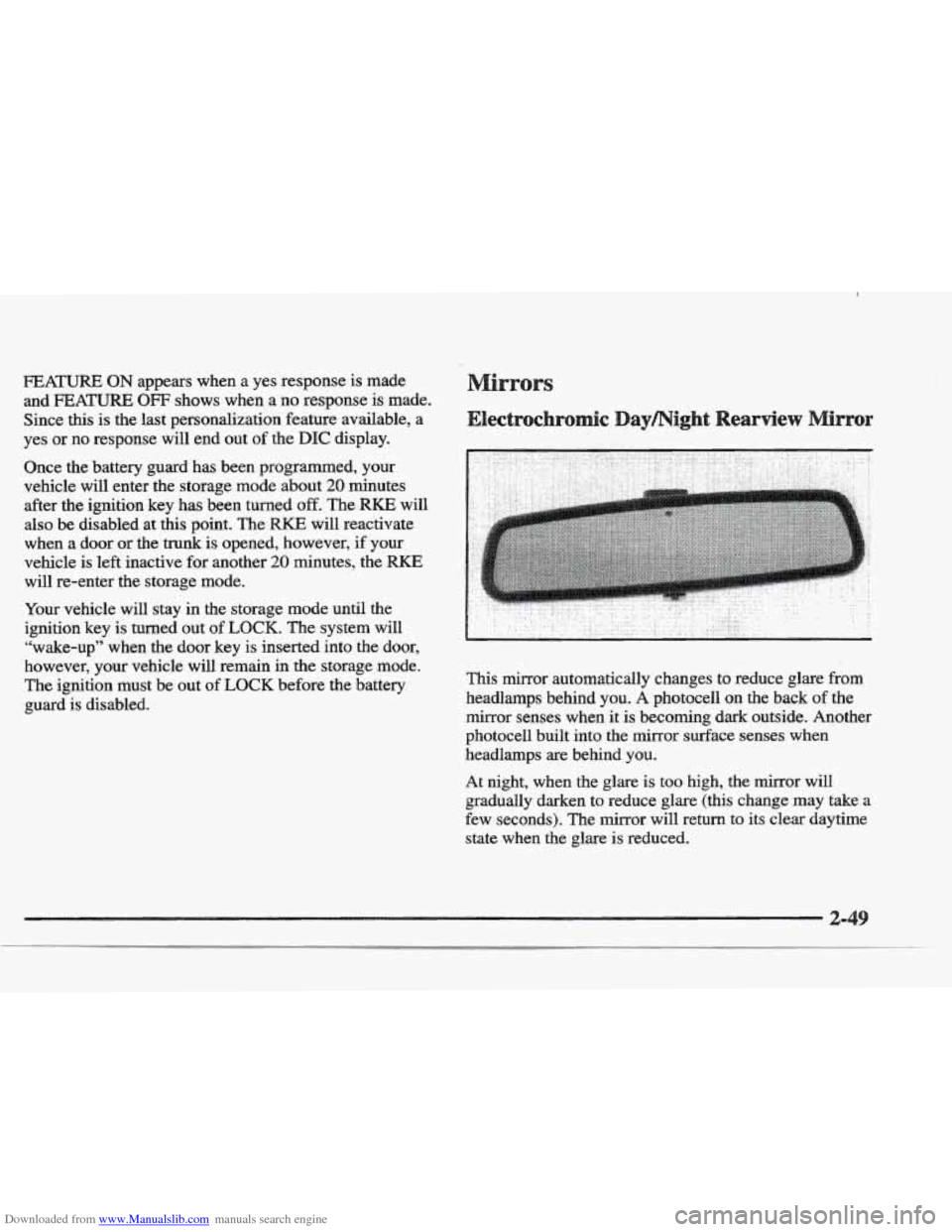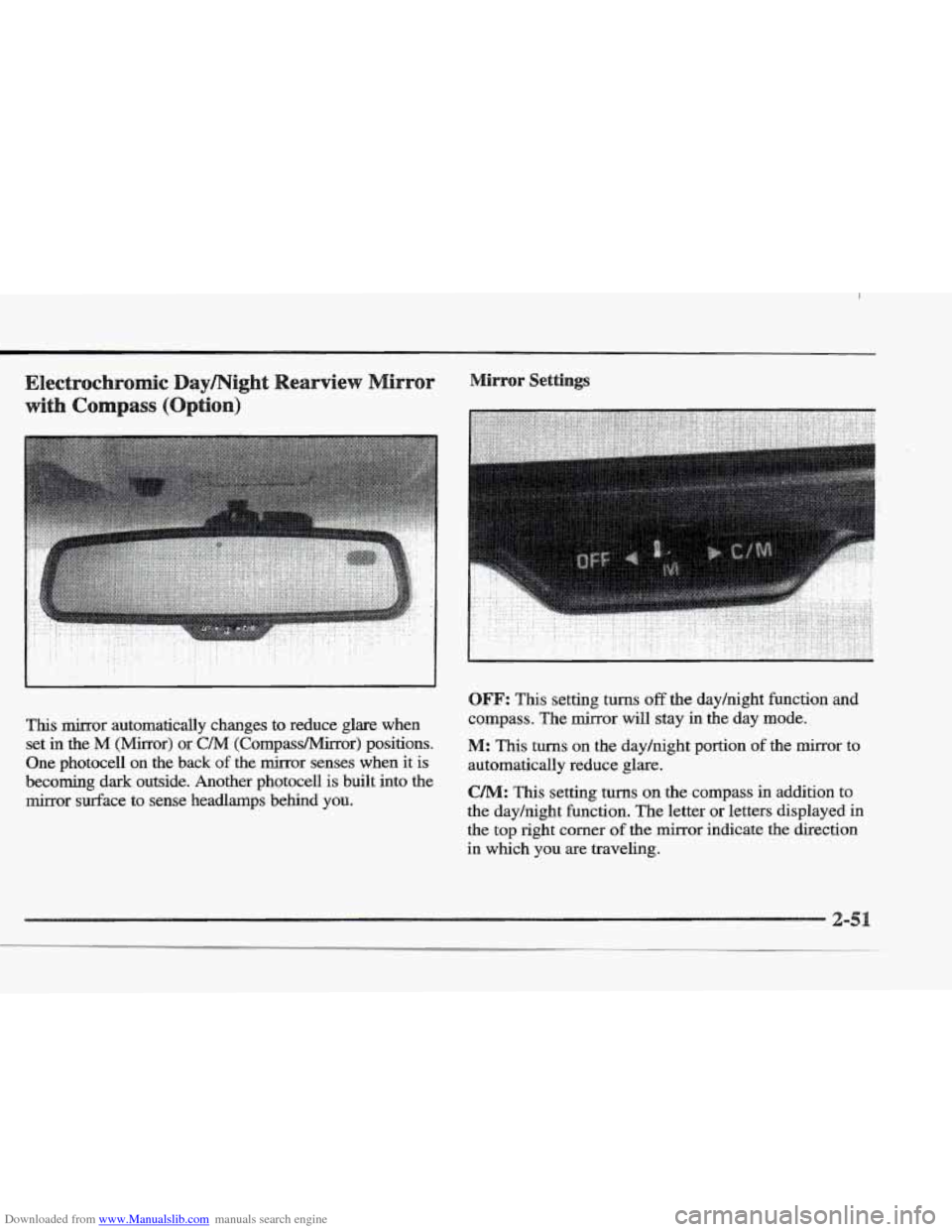1997 CADILLAC ELDORADO headlamp
[x] Cancel search: headlampPage 110 of 361

Downloaded from www.Manualslib.com manuals search engine The light sensor for the DRL and the twilight sentinel is
located in the center of
the fiont defogger grrlle. pf you cover
the sensor, it will read “dark”
and the lamps will come on.
If the manual park lamp control has been left on, the
exterior lamps will
turn off approximately 10 minutes
after the ignition
is turned to LOCK or ACCESSORY.
This protects draining the battery in case you have
accidently
left the headlamps or parkmg lamps on. If
you need to purposely leave the Imps on for more than
10 minutes, use the manual control knob to turn the
lamps back on.
To delay the lamps from turning off, see
“Twilight Sentinel” earlier in this section. Cluster lighting
as well
as instrument panel lighting
automatically dims when it becomes dark outside.
When it’s dark,
the brightness control can be manually
adjusted. Cluster lighting and instrument panel lighting
automatically brighten when it becomes light outside.
The illuminated entry system
turns on the courtesy
lamps and the backlighting to the door switches and
to
the lamp contr~l knob when a door is opened or if you
press a RKE transmitter button. Since the illuminated
entry system has
a photocell, this means that it must
be dark outside
in order for the courtesy lamps or
backlighting
to turn on. The courtesy lamps turn off
approximately 20 seconds after the last door is closed or
after the ignition key
is placed in the ignition.
This feature prohibits the dimming of the instrument
panel lights during daylight while
the headlamps are on.
This feature operates with the light sensor for the
twilight sentinel and is fully automatic. When the light
sensor reads darkness outside,
the instrument panel
lights can
be adjusted. Backlighting to the instrument
panel will
also turn on.
Page 112 of 361

Downloaded from www.Manualslib.com manuals search engine FEATURE ON appears when a yes response is made
and
FEATURE OFF shows when a no response is made.
Since this
is the last personalization feature available, a
yes or no response
will end out of the DIC display.
Once the battery guard has been programmed, your
vehicle will enter the storage mode about
20 minutes
after the ignition key
has been turned off. The WKE will
also be disabled at this point. The RKE will reactivate
when a door
or the trunk is opened, however, if your
vehicle is left inactive for another
20 minutes, the RKE
will re-enter the storage mode.
Your vehicle will stay
in the storage mode until the
ignition key is turned out
of LOCK. The system will
“wake-up” when the door key is inserted
into the door,
however,
your vehicle will remain in the storage mode.
The ignition must be out of
LOCK before the battery
guard is disabled. This mirror automatically changes to reduce
glare from
headlamps behind you. A photocell on the back of the
mirror senses when it
is becoming dark outside. Another
photocell built into the mirror surface senses when
headlamps are behind you.
At night, when the glare is too high, the mirror will
gradually darken to reduce glare (this change
may take a
few seconds). The mirror will return
to its clear daytime
state
when the glare is reduced.
Page 114 of 361

Downloaded from www.Manualslib.com manuals search engine This mirror automatically changes to reduce glare when set
in the M (Mirror) or C/M (Compass/Mirror) positions.
One photocell
on the back of the mirror senses when it is
becoming
dark outside. Another photocell is built into the
mirror surface to sense headlamps behind YOU.
.. :. .. .. ..
. . . . . . . . .. . : ..
OFF: This setting turns off the dayhight function and
compass. The mirror will stay in the day mode.
M: This turns on the dayhight portion of the mirror to
automatically reduce glare.
CAM: This setting turns on the compass in addition to
the day/night function. The letter
or letters displayed in
the
top right corner of the mirror indicate the direction
in which
you are traveling.
Page 117 of 361

Downloaded from www.Manualslib.com manuals search engine Your Cadillac has an
electric mirror control
located
on the
driver’s door armrest.
Move the switch
in the middle of the control to choose
the right or left
mirror. To adjust the mirror, push the
arrow control in the direction YOU want the mirror to go.
Adjust each mirror so you can see the side of your
vehicle and the area behind your vehicle. The
mirrors can
also be programmed for personalization
if you have the optional memory package. For more
information, see “Memory Seat
and Mirrors” in
the Index.
in
Only the driver’s side outside mirror will adjust for the
controlled by
the on and off settings on the
electrochromic mirror. See “Electrochromic Day/Night
Rearview Mirror” earlier
in this section.
b ulare of headlamps behind you. This feature is
Page 150 of 361

Downloaded from www.Manualslib.com manuals search engine ENGINE COOLANT HOT-IDLE ENGINE - 44:
This message will appear when the engine coolant
temperature is over
248 OF (1 26 O C). To avoid added
strain
on a hot engine, turn off the climate control system.
Stop and allow your vehcle to idle until it cools down or
the message is removed. If it does not cool down, turn
off
the engine and have it serviced before driving it again.
Severe engine damage can result
from an overheated
engine. See “Engine Overheating”
in the Index.
ENGINE MISFIRE -- EASE OFF GAS
PEDAL - 1114: An engine misfire has occurred.
You’ll need to ease
off the gas pedal.
FUEL LEVEE LOW - 11: This message serves as a
warning that the
fuel level in the tank is critically low.
Stop for fuel soon.
ICE POSSIBLE - 13: This message appears when
the outside air temperature
is cold enough to create icy
road conditions.
HEADLAMBS SUGGESTED - 23: If it’s dark enough
outside and the twilight sentinel control is
off, a
FEADLAMPS SUGGESTED message will display on the
DIC. This message informs the driver that turning on the
exterior
lamps is recommended even though the DRL are
still illuminated. (It has become dark enough outside to
require the headlamps and/or other exterior lamps.)
MONITORED SYSTEMS OK - I: This message only
appears
in the “recall” mode by pressing the RESET
button. It lets you know that no other messages are
stored or currently active.
FASS KEY NOT PROGRAMMED - 31: This
warning message displays when the PASS-Key pellet
information has not been programmed into your vehicle.
See your Cadillac dealership for service.
PCM FAULT - 110: The circuit in the Powertrain
Control Module (PCM) has shorted or
is loose when this
message appears. Have your Cadillac serviced by your
dealership at once.
REDUCED ENGINE POWER - 41: This message
informs the driver, that due to wheel slippage, your
vehicle is reducing engine power to compensate for
the loss of traction. Accelerating too fast, causing the
tires to spin, is an example of when this message
would display.
IREMOVE KEY - 70: This message will appear when
the Personalized Automotive Security System
(PASS-Key 11) is unable to read the pellet on the
ignition key or an improper key pellet has been inserted.
Wait for the
DIC to display STARTING DISABLED
DUE TO THEFT
SYSTEM REMOVE IGNITION
KEY. The instrument panel cluster will then run a timer
and change the messages
to WAIT 3 MINUTES, WAIT
Page 201 of 361

Downloaded from www.Manualslib.com manuals search engine Night driving is more dangerous than day driving. One
reason
is that some drivers are likely to be impaired -- by
alcohol or
drugs, with night vision problems, or by fatigue. Here
are some tips on night driving.
.I 4,
a
e
e
a
0
0
Drive defensively.
Don’t
drink and drive. . . .t
Since you can’t see as well, you may need to
slow down and keep more space between you and
other vehicles.
Slow down, especially
on higher speed roads. Your
headlamps
.can light up only so much road ahead.
In remote areas, watch for animals.
If you’re tired, pull off
the road in a safe place
and rest.
i 4-66 I
I
Page 202 of 361

Downloaded from www.Manualslib.com manuals search engine No one can see as well at night as in the daytime. But as
we get older these differences increase.
A 50-year-old
driver may require at least twice as much light to see
the
same thing at night as a 20-year-old.
What you
do in the daytime can also affect your night
vision. For example,
if you spend the day in bright
sunshine you are wise
to wear sunglasses. Your eyes will
have less trouble adjusting to night. But
if you’re
driving, don’t wear sunglasses at night. They may cut
down on glare from headlamps, but they also make
a lot
of things invisible.
You can be temporarily blinded by approaching
headlamps.
It can take a second or two, or even several
seconds, for your eyes to readjust to the dark. When you
are faced with severe glare (as from a driver who
doesn’t lower the high beams, or
a vehicle with
misaimed headlamps),
slow down a little. Avoid staring
directly into the approaching headlamps. Keep your windshield and all the
glass on your vehicle
clean
-- inside and out. Glare at night is made much
worse by dirt on the glass. Even the inside of
the glass
can build up a film caused by dust. Dirty glass makes
lights dazzle and flash more than clean glass would,
making
the pupils of your eyes contract repeatedly.
Remember that your headlamps light
up far less of a
roadway when you are in a turn or curve. Keep your
eyes moving; that
way, it’s easier to pick out dlmly
lighted objects. Just as your headlamps should be
checked regularly for proper aim,
SO should your eyes
be examined regularly. Some drivers suffer from night
blindness
-- the inability to see in dim light -- and
aren’t even aware
of it.
Page 215 of 361

Downloaded from www.Manualslib.com manuals search engine Run your engine 'only as long'as you must. This saves
fuel. When you run the engine, make it go a little faster
than just idle. That is, push the accelerator slightly.
This
uses less fuel for the-heat that you get and it keeps the
battery charged.
You will need a well-charged battery to
restart the vehicle, and.possibly.for signaling
later on
with your headlamps. Let-the heater
run for awhile.
Then, shut'the ,engine
off 'and close the window almost
all the way to preserve the heat.
Start the engine again
and repeat this only when you feel really uncornfortable
from the cold. But do it as little
as possible. Preserve the
fuel as long as you can. To help keep warm, you can get
out of the vehicle and
do some fairly vigorous exercises
every half hour or
so until help comes.
.- . ,* . . _.
oading Your Ve
;" 1.
TIRE-LOA.DING INFORMATION
OCCUPANTS VEHICLE
CAP. WT.
FRT. CTR. RR. TOTAL LBS. KG
MAX. LOADING & GWR SAME AS VEHICLE
CAPACITY WEIGHT XXX COLD TIRE
TIRE SIZE SPEED PRESSURE
RTG
PSVKPa
FRT.
RR.
SPA.
IF TIRES ARE HOT, ADD 4PSV28KPa
SEE OWNER'S MANUAL FOR ADDITIONAL
. INFORMATION
Two labels on your.vehicle show how much weight it
may properly
carry. The Tire-Loading Information label
found
on the driver's door tells you the proper size,
speed rating and recommended inflation pressures for
the tires on your vehicle. It also gives you important
infomation
about the number of people that can be in
your vehicle and the total weight that you can carry.
This weight is called the Vehicle Capacity Weight and
includes the weight of all occupants, cargo and all
options not installed in the factory.